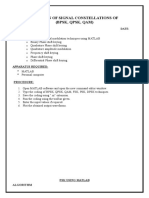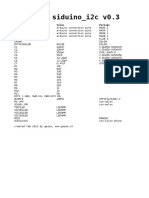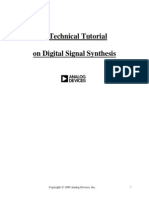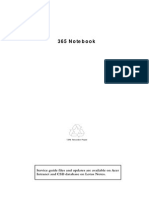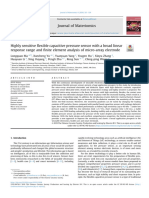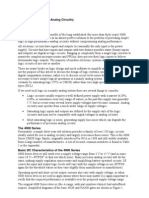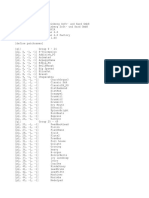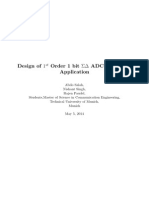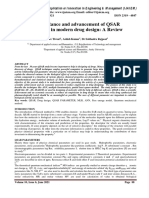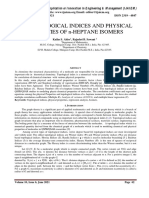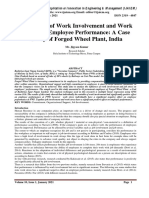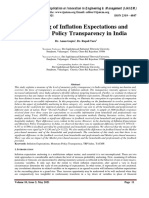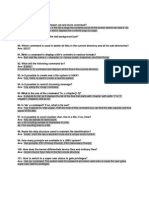Field Programmable Gate Array Implementation of 14 Bit Sigma-Delta Analog To Digital Converter
Field Programmable Gate Array Implementation of 14 Bit Sigma-Delta Analog To Digital Converter
I nt ernat i onal Journal of E mergi ng Trends & Technol ogy i n Comput er Sci ence (I JE TTCS)
Web Site: www.ijettcs.org Email: editor@ijettcs.org, editorijettcs@gmail.com
Volume 1, Issue 2, July August 2012 ISSN 2278-6856
Vol ume 1 , I ssue 2 Jul y-August 2 0 1 2 Page 2 2 9
Abstract: This paper the design and FPGA implementation
of a delta sigma A/D convertor. The proposed converter has
been designed using Xilinx system generator tool, which
reduces the design cycle by directly generating efficient
VHDL code. The VHDL code has been implemented on a
Spartan 3E xc3s100e-4vq100 FPGA using ISE 12.4 tool.
Keywords: Analog to Digital Convertor, Field
Programmable Gate Array, SigmaDelta, System
Generator, Xilinx.
1. INTRODUCTION
The most important advantages of digital processing over
analog processing are a perfect storage of digitized
signals, unlimited signal-to-noise ratio, the option to
carry out complex calculations, and the possibility to
adapt the algorithm of the calculation to changing
circumstances[10]. If an application wants to use these
advantages, analog signals have to be converted with high
quality into a digital format in an early stage of the
processing chain. And at the end of the digital processing
the conversion has to be carried out in the reverse
direction. The digital-to-analog translates the outcome of
the signal processing into signals that can be rendered as
a picture or sound. This makes analog-to-digital (A/D)
conversion a crucial element in the chain between our
world of physical quantities and the rapidly increasing
power of digital signal processing. Fig 1 shows the
(ADC) as the crucial element in a system.
Figure 1: The A/D and D/A converters [10]
The work on electronic ADC was started with the
invention of Pulse code modulation (PCM) in 1921[1]. A
significant development in ADC technology during the
period was the electron beam coding tube described by R.
W. Sears in [4]. The basic algorithm used in the
successive approximation ADC conversion is based on
the determination of an unknown weight by a minimal
sequence of weighing operations [5]. Later CMOS was
the ideal process for the sigma-delta (-) architecture,
which became the topology of choice for ADCs used in
voice band and audio applications, as well as in higher
resolution, low frequency measurement converters. The
- architecture began to replace the parallel ADCs in
audio applications. - offered much higher
oversampling ratios, thereby relaxing output filter
requirements, as well as provided higher dynamic range
with lower distortion. In this paper - ADC has been
implemented on FPGA using system generator tool by
Xilinx. The performance of the - ADC has also
evaluated by converting its digital output again into
analog domain.
2. PRELIMINARIES OF A/D CONVERSION
Signals, in general, can be divided into two categories an
analog signal, x(t), which can be defined in a continuous-
time domain and a digital signal, x(n), which can be
represented as a sequence of numbers in a discrete-time
domain as shown in Fig 2. The time index n of a discrete-
time signal x(n) is an integer number defined by sampling
interval T[8]. Thus, a discrete- time signal, x*(t), can be
represented by a sampled continuous-time signal x(t) as:
*( ) ( ) ( )
n
x t x t t nT
=
=
(1)
Where,
( ) 1 t =
, 0 t =
0, elsewhere
Most ADCs can be classified into two groups according to
the sampling rate criteria. Nyquist rate converters, such
as a successive approximation register (SAR), double A
practical A/D converter transforms x(t) into a discrete-
time digital signal, x*(t), where each sample is expressed
Field Programmable Gate Array
Implementation of 14 bit Sigma-Delta Analog
to Digital Converter
Sukhmeet Kaur
1
, Parminder Singh Jassal
2
1
M.Tech Student , Department of Electronics and Communication Engineering, Yadavindra College of Engineering, Punjabi
University Guru kashi Campus , Talwandi Sabo 151 302 , Punjab (India)
2
Assistant Prof., Department of Electronics and Communication Engineering, Yadavindra College of Engineering, Punjabi
University Guru kashi Campus , Talwandi Sabo 151 302 , Punjab (India)
I nt ernat i onal Journal of E mergi ng Trends & Technol ogy i n Comput er Sci ence (I JE TTCS)
Web Site: www.ijettcs.org Email: editor@ijettcs.org, editorijettcs@gmail.com
Volume 1, Issue 2, July August 2012 ISSN 2278-6856
Vol ume 1 , I ssue 2 Jul y-August 2 0 1 2 Page 2 3 0
with finite precision. Each sample is approximated by a
digital code, i.e., x(t) is transformed into a sequence of
finite precision or quantized samples x(n). Integration,
and oversampling converters, sample analog signals
which have maximum frequencies slightly less than the
Nyquist frequency, f
N
= fs/ 2, where fs is the sampling
frequency [2]. Meanwhile, oversampling converters
perform the sampling process at a much higher rate, f
N
<< Fs, where Fs denotes the input sampling rate.
Figure 2: Generalized ADC process [8]
Fig. 3 illustrates the conventional A/D conversion process
that transforms an analog input signal x(t) into a
sequence of digital codes x(n) at a sampling rate of fs =
1/T, where T denotes the sampling interval.
Figure 3: Conventional ADC process [8]
( 2 )/
1
( ) ( ) ( )
j n t T
n n
x t t nT x t e
T
= =
=
(2)
also
2 ( 2 )/
1 1
*( ) ( ) ( )
s
j f nt j n t T
n n
x t x t e x t e
T T
= =
= =
(3)
Eqn. 2 states that the act of sampling (i.e., the sampling
function):
( ) ( )
n
x t t nT
=
is equivalent to modulating the input signal by carrier
signals having frequencies at 0, fs, 2fs,. . .. In other
words, the sampled signal can be expressed in the
frequency domain as the summation of the original signal
component and signals frequency modulated by integer
multiples of the sampling frequency Thus, input signals
above the Nyquist frequency, f
n
, cannot be properly
converted and they also create new signals in the base-
band, which were not present in the original signal. This
non-linear phenomenon is a signal distortion frequently
referred to as aliasing [6]. The distortion can only be
prevented by properly lowpass filtering called the anti-
aliasing filter. In addition to an anti-aliasing filter, a
sample and hold circuit is required. Although the analog
signal is continuously changing, the output of the sample
and hold circuitry must be constant between samples so
the signal can be quantized properly. This allows the
converter enough time to compare the sampled analog
signal to a set of reference levels that are usually
generated internally [7]. If the output of the sample-and-
hold circuit varies during T, it can limit the performance
of the A/D converter subsystem.Each of these reference
levels is assigned a digital code. The process of
converting an analog signal into a finite range number
system introduces an error signal that depends on how the
signal is being approximated. This quantization error is
on the order of one least-significant-bit in amplitude, and
it is quite small compared to full-amplitude signals.
However, as the input signal gets smaller, the
quantization error becomes a larger portion of the total
signal. When the input signal is sampled to obtain the
sequence x (n), each value is encoded using finite word
lengths of B-bits including the sign bit. Assuming the
sequence is scaled such that ( ) 1 x n s for fractional
number representation, the pertinent dynamic range is 2.
Since the encoder employs B-bits, the number of levels
available for quantizing x (n) is 2
B
. The interval
between successive levels, q, is therefore given by:
1
1
2
B
q
=
(4)
which is called the quantization step size. Mean square
value of quantization error can be calculated as [5]:
/ 2
2 2
2 2 2
( )/2
1 2
12 3
q
B
e
q
q
E e e de
q
= = = =
}
(5)
where E denotes statistical expectation
3. - A/D CONVERTER
Fig. 4 shows the block diagram of a - A/D converter.
The 1-bit digital output from the modulator is supplied to
a digital decimation filter which yields a more accurate
representation of the input signal at the output sampling
rate of fs. In the figure is a first-order - modulator. It
consists of an analog difference node, an integrator, a 1-
bit quantizer (A/D converter), and a 1-bit D/A converter
in a feed- back structure. The modulator output has only
1-bit (two levels) of information, i.e., 1 or -1. The
modulator output y(n) is converted to x(t) by a 1-bit D/A
converter. The input to the integrator in the modulator is
the difference between the input signal x(t) and the
quantized output value y(n) converted back to the
I nt ernat i onal Journal of E mergi ng Trends & Technol ogy i n Comput er Sci ence (I JE TTCS)
Web Site: www.ijettcs.org Email: editor@ijettcs.org, editorijettcs@gmail.com
Volume 1, Issue 2, July August 2012 ISSN 2278-6856
Vol ume 1 , I ssue 2 Jul y-August 2 0 1 2 Page 2 3 1
predicted analog signal, x(t). Provided that the D/A
converter is perfect, and neglecting signal delays, this
difference between the input signal x(t) and the fed back
signal x(t) at the integrator input is equal to the
quantization error. This error is summed up in the
integrator and then quantized by the 1-bit A/D converter.
Figure 4: Block Diagram of Sigma delta A/D converter
[8]
Although the quantization error at every sampling
instance is large due to the coarse nature of the two level
quantizer, the action of the - modulator loop is to
generate a 1 output which can be averaged over several
input sample periods to produce a very precise result. The
averaging is performed by the decimation filter which
follows the modulator.
4. FPGA IMPLEMENTATION OF - ADC
- ADC has been implemented using System Generator
tool of Xilinx, which reduces the design cycle. The
snapshot of the ADC has been shown in Fig 5.
Figure 5: Snapshot of the Set-Up
Fig. 6 shows the block diagram of ADC. ADC employs a
sequential binary search to arrive at the appropriate
output sample. The sample rate of the ADC is computed
as
( )
( ) ( )
( )
1
2 1 1
clk
sr
MSBI
mst
f
ADC
F MSBI
+
=
+ +
Samples/sec (6)
Where is the most significant bit of the DAC input
and is filter settle time constant.This approach
makes the ADC unsuitable for applications requiring a
high sampling rate. The 'ADC
Out
Register' captures the
reference shifter output after a sample has been computed,
then produces the ADC output sample. The 'ADC
Out
Register' captures the reference shifter output after a
sample has been computed, then produces the ADC
output sample. The 'ADC
Out
Register' captures the
reference shifter output after a sample has been computed,
then produces the ADC output sample. The 'ADC
Out
Register' captures the reference shifter output after a
sample has been computed, then produces the ADC
output sample.
4
sampl e
3
ADC_Sampl ed
2
ADCout
1
DAC_dri ver
z
-1
a
b
a = b
z
-1
rel1
z
-1
and
l 2
z
-1
and
l 1
z
-1
[a:b]
a
b
a = b
AgtR
shif t
mask
ref _shif ter
Reference
Shifter
shif t mask
Mask
Shi fter
[shi ft]
[shi ft] l oad
di n
en
--
FSTM
Counter
++
DAC Sampl e
Counter
0
0
d
en
q z
-1
ADCOut
Regi ster
0
'c1'
1
AgtR
Figure 6: Block Diagram of ADC
1
DAC_Out
d
rst
q z
-1
r1
[a:b]
a
b
a + b
Sigma Adder
d
rst
q z
- 1
a
b
a + b
Delta
Adder
0
0
0
hi
l o
}
hi
l o
}
1
DAC_In
Figure 7: Block Diagram of DAC
Fig. 7 shows block diagram of DAC. The Delta Adder
computes the difference between the current DAC input
and the current DAC output. The two concatenators
create a 16-bit output with the DAC output copied in the
two MSB positions. This effectively creates a difference
from the Delta Adder when the DAC output is 1. The
Sigma Adder accumulates the differences produced by the
Delta Adder by using 'r
1
' to storing the adder output on
each successive cycle. The MSB of the 'r
1
' output is sliced
off and provides the DAC output. The pulse string is
I nt ernat i onal Journal of E mergi ng Trends & Technol ogy i n Comput er Sci ence (I JE TTCS)
Web Site: www.ijettcs.org Email: editor@ijettcs.org, editorijettcs@gmail.com
Volume 1, Issue 2, July August 2012 ISSN 2278-6856
Vol ume 1 , I ssue 2 Jul y-August 2 0 1 2 Page 2 3 2
registered before it is driven on the DAC output port. The
proposed ADC has been verified by converting its output
back to analog domain by using DAC. Table 1 shows the
comparison of ADC input and output of DAC. The results
show that the proposed design is quite accurate in
converting the analog data into digital data. The small
error shown in Table 1 may be a due to inaccuracy of
DAC.
Figure 8: Internal View of Top Level RTL Schematic of
Proposed ADC
The summary of the resources utilized has been shown in
table 2.
Table 2: Resource Utilization for Spartan 3E xc3s100e-
4vq 100Device
Device Utilization Summary (estimated values)
Logic Utilization Used Available Utilization
Number of Slices 38 960 3%
Number of Slice Flip Flops 55 1920 2%
Number of 4 input LUTs 45 1920 2%
Number of bonded IOBs 3 66 4%
Number of GCLKs 1 24 4%
5. CONCLUSION
This paper presents the design and implementation of
proposed - ADC. The proposed design has been
implemented on Spartan 3E xc3s100e-4vq 100 FPGA
Device and only consumes 38 number of slices, number of
55 Slice Flip Flops, 45 number of 4 input LUTs, 3
number of bonded IOBs and 1 number of GCLKs out of
available 960, 1920, 1920, 66 and 24 respectively. The
proposed design has also been verified for its accuracy.
REFERENCES
[1] Paul M. Rainey, "Facimile Telegraph System," U.S.
Patent 1,608,527, filed July 20, 1921, issued
November 30, 1926.
[2] H. Nyquist, "Certain Factors Affecting Telegraph
Speed," Bell System Technical Journal, Vol. 3,
April 1924, pp. 324-346.
[3] H. S. Black, "Pulse Code Modulation," Bell Labs
Record, Vol. 25, July 1947, pp. 265-269.
[4 R. W. Sears, "Electron Beam Deflection Tube for
Pulse Code Modulation," Bell System Technical
Journal, Vol. 27, pp. 44-57, Jan. 1948.
[5] W. W. Rouse Ball and H. S. M. Coxeter,
Mathematical Recreations and Essays, Thirteenth
Edition, Dover Publications, 1987, pp. 50, 51.
[6] H. Nyquist, Certain topics in telegraph
transmission theory, AIEE Trans., pp. 617-644,
1928.
[7] M. Armstrong, et al, A COMS programmable self-
calibrating 13b eight-channel analog interface
processor, ISSCC Dig. Tech. Paper, pp. 44-45,
Feb. 1987.
[8] Sangil Park, Principles of Sigma-Delta Modulation
for Analog-to- Digital Converters Motorola
Digital Signal Processors.
[9] Ms.N.P.Pendharkar, Dr.K.B.Khanchandani Design,
Development & Performance Investigations of
Sigma-Delta ADC using CMOS Technology,
International Journal of Advanced Engineering &
Application, Jan 2011 Issue
[10] Marcel J.M. Pelgrom Analog-to-Digital
Conversion http://www.scribd.com/doc/60454030/
Analog-to-Digital-Conversion.
You might also like
- BassGorilla Composition Masterclass E-BookNo ratings yetBassGorilla Composition Masterclass E-Book70 pages
- Jetking Certified Hardware and Networking ProfessionalNo ratings yetJetking Certified Hardware and Networking Professional13 pages
- Simplified Analogue Realization of The Digital Direct Synthesis (DDS) Technique For Signal GenerationNo ratings yetSimplified Analogue Realization of The Digital Direct Synthesis (DDS) Technique For Signal Generation5 pages
- Ca4 - Designing and Implementing FiltersNo ratings yetCa4 - Designing and Implementing Filters9 pages
- High-Performance and Wearable Strain Sensors Based On GrapheneNo ratings yetHigh-Performance and Wearable Strain Sensors Based On Graphene6 pages
- Low-Cost Pressure Sensor Matrix Using VelostatNo ratings yetLow-Cost Pressure Sensor Matrix Using Velostat5 pages
- Current Feedback Operational Amplifier Wikipedia The Free Encyclopedia100% (1)Current Feedback Operational Amplifier Wikipedia The Free Encyclopedia4 pages
- A Comparative Performance Analysis of Capacitive and Piezoresistive MEMS For Pressure MeasurementNo ratings yetA Comparative Performance Analysis of Capacitive and Piezoresistive MEMS For Pressure Measurement4 pages
- Digital Signal Synthesis DDS - Tutorial - Rev12!2!99No ratings yetDigital Signal Synthesis DDS - Tutorial - Rev12!2!99122 pages
- Acer 365 Notebook Service Manual - Parts and Service ManualNo ratings yetAcer 365 Notebook Service Manual - Parts and Service Manual126 pages
- Digital Signal Processing Lab Manual: Subject Code: ECE 3161No ratings yetDigital Signal Processing Lab Manual: Subject Code: ECE 316145 pages
- High Order Programmable and Tunable Analog Filter ICNo ratings yetHigh Order Programmable and Tunable Analog Filter IC16 pages
- A Basic Introduction To Filters, Active, Passive, and Switched Capacitor100% (1)A Basic Introduction To Filters, Active, Passive, and Switched Capacitor22 pages
- Impulse Response: Mathematical ConsiderationsNo ratings yetImpulse Response: Mathematical Considerations4 pages
- Impulse Response of Frequency Domain ComponentNo ratings yetImpulse Response of Frequency Domain Component17 pages
- CMOS Sample-and-Hold Circuits: ECE 1352 Reading AssignmentNo ratings yetCMOS Sample-and-Hold Circuits: ECE 1352 Reading Assignment15 pages
- Laporan Simulasi: Praktikum Telekomunikasi DigitalNo ratings yetLaporan Simulasi: Praktikum Telekomunikasi Digital9 pages
- S-38.220 Licentiate Course On Signal Processing in Communications, FALL - 97No ratings yetS-38.220 Licentiate Course On Signal Processing in Communications, FALL - 9715 pages
- Detection of Malicious Web Contents Using Machine and Deep Learning ApproachesNo ratings yetDetection of Malicious Web Contents Using Machine and Deep Learning Approaches6 pages
- Detection of Malicious Web Contents Using Machine and Deep Learning ApproachesNo ratings yetDetection of Malicious Web Contents Using Machine and Deep Learning Approaches6 pages
- An Importance and Advancement of QSAR Parameters in Modern Drug Design: A ReviewNo ratings yetAn Importance and Advancement of QSAR Parameters in Modern Drug Design: A Review9 pages
- THE TOPOLOGICAL INDICES AND PHYSICAL PROPERTIES OF n-HEPTANE ISOMERSNo ratings yetTHE TOPOLOGICAL INDICES AND PHYSICAL PROPERTIES OF n-HEPTANE ISOMERS7 pages
- An Importance and Advancement of QSAR Parameters in Modern Drug Design: A ReviewNo ratings yetAn Importance and Advancement of QSAR Parameters in Modern Drug Design: A Review9 pages
- Study of Customer Experience and Uses of Uber Cab Services in MumbaiNo ratings yetStudy of Customer Experience and Uses of Uber Cab Services in Mumbai12 pages
- Customer Satisfaction A Pillar of Total Quality ManagementNo ratings yetCustomer Satisfaction A Pillar of Total Quality Management9 pages
- Analysis of Product Reliability Using Failure Mode Effect Critical Analysis (FMECA) - Case StudyNo ratings yetAnalysis of Product Reliability Using Failure Mode Effect Critical Analysis (FMECA) - Case Study6 pages
- Study of Customer Experience and Uses of Uber Cab Services in MumbaiNo ratings yetStudy of Customer Experience and Uses of Uber Cab Services in Mumbai12 pages
- Performance of Short Transmission Line Using Mathematical MethodNo ratings yetPerformance of Short Transmission Line Using Mathematical Method8 pages
- Soil Stabilization of Road by Using Spent WashNo ratings yetSoil Stabilization of Road by Using Spent Wash7 pages
- The Effect of Work Involvement and Work Stress On Employee Performance: A Case Study of Forged Wheel Plant, IndiaNo ratings yetThe Effect of Work Involvement and Work Stress On Employee Performance: A Case Study of Forged Wheel Plant, India5 pages
- The Mexican Innovation System: A System's Dynamics PerspectiveNo ratings yetThe Mexican Innovation System: A System's Dynamics Perspective12 pages
- Staycation As A Marketing Tool For Survival Post Covid-19 in Five Star Hotels in Pune CityNo ratings yetStaycation As A Marketing Tool For Survival Post Covid-19 in Five Star Hotels in Pune City10 pages
- The Impact of Effective Communication To Enhance Management SkillsNo ratings yetThe Impact of Effective Communication To Enhance Management Skills6 pages
- Design and Detection of Fruits and Vegetable Spoiled Detetction SystemNo ratings yetDesign and Detection of Fruits and Vegetable Spoiled Detetction System8 pages
- Anchoring of Inflation Expectations and Monetary Policy Transparency in IndiaNo ratings yetAnchoring of Inflation Expectations and Monetary Policy Transparency in India9 pages
- Impact of Covid-19 On Employment Opportunities For Fresh Graduates in Hospitality &tourism IndustryNo ratings yetImpact of Covid-19 On Employment Opportunities For Fresh Graduates in Hospitality &tourism Industry8 pages
- A Deep Learning Based Assistant For The Visually ImpairedNo ratings yetA Deep Learning Based Assistant For The Visually Impaired11 pages
- A Comparative Analysis of Two Biggest Upi Paymentapps: Bhim and Google Pay (Tez)No ratings yetA Comparative Analysis of Two Biggest Upi Paymentapps: Bhim and Google Pay (Tez)10 pages
- Design and Manufacturing of 6V 120ah Battery Container Mould For Train Lighting ApplicationNo ratings yetDesign and Manufacturing of 6V 120ah Battery Container Mould For Train Lighting Application13 pages
- Analysis of RCC Beam Using GFRP Wrapped With Cellular StirrupsNo ratings yetAnalysis of RCC Beam Using GFRP Wrapped With Cellular Stirrups11 pages
- Swot Analysis of Backwater Tourism With Special Reference To Alappuzha DistrictNo ratings yetSwot Analysis of Backwater Tourism With Special Reference To Alappuzha District5 pages
- Application of Mersey Silt As Fine Aggregate in ConcreteNo ratings yetApplication of Mersey Silt As Fine Aggregate in Concrete9 pages
- Marco Economic Sustainability in India: Partisan Theory ApproachNo ratings yetMarco Economic Sustainability in India: Partisan Theory Approach7 pages
- Oral Presentation Guidelines: 1. Audio/Visual & Equipment AvailableNo ratings yetOral Presentation Guidelines: 1. Audio/Visual & Equipment Available2 pages
- 208-The Decline and Fall of BIND 10 PDFNo ratings yet208-The Decline and Fall of BIND 10 PDF24 pages
- Atmel 11121 32 Bit Cortex A5 Microcontroller SAMA5D3 DatasheetNo ratings yetAtmel 11121 32 Bit Cortex A5 Microcontroller SAMA5D3 Datasheet1,817 pages
- Design Phase of Matrimonial Web-ApplicationNo ratings yetDesign Phase of Matrimonial Web-Application10 pages
- 2003 International Currency Technologies Corporation Vol. 5.0 Part Number: H4519D-RNo ratings yet2003 International Currency Technologies Corporation Vol. 5.0 Part Number: H4519D-R8 pages
- Eurosec Course Material On Web Application Session ManagementNo ratings yetEurosec Course Material On Web Application Session Management25 pages
- Technical Note - Loading FortiGate Firmware Image Using TFTPNo ratings yetTechnical Note - Loading FortiGate Firmware Image Using TFTP4 pages
- Upgrade Guidance For HD Cameras: Preparation Before UpgradingNo ratings yetUpgrade Guidance For HD Cameras: Preparation Before Upgrading3 pages
- openSAP Ui51 Week2 Unit7 Bonus Exercise PDFNo ratings yetopenSAP Ui51 Week2 Unit7 Bonus Exercise PDF4 pages
- Linux System Administrator Interview Questions You'll Most Likely Be AskedNo ratings yetLinux System Administrator Interview Questions You'll Most Likely Be Asked19 pages
- Quectel GSM TCPIP Recommended Process V2.0No ratings yetQuectel GSM TCPIP Recommended Process V2.021 pages
- Jetking Certified Hardware and Networking ProfessionalJetking Certified Hardware and Networking Professional
- Simplified Analogue Realization of The Digital Direct Synthesis (DDS) Technique For Signal GenerationSimplified Analogue Realization of The Digital Direct Synthesis (DDS) Technique For Signal Generation
- High-Performance and Wearable Strain Sensors Based On GrapheneHigh-Performance and Wearable Strain Sensors Based On Graphene
- Current Feedback Operational Amplifier Wikipedia The Free EncyclopediaCurrent Feedback Operational Amplifier Wikipedia The Free Encyclopedia
- A Comparative Performance Analysis of Capacitive and Piezoresistive MEMS For Pressure MeasurementA Comparative Performance Analysis of Capacitive and Piezoresistive MEMS For Pressure Measurement
- Digital Signal Synthesis DDS - Tutorial - Rev12!2!99Digital Signal Synthesis DDS - Tutorial - Rev12!2!99
- Acer 365 Notebook Service Manual - Parts and Service ManualAcer 365 Notebook Service Manual - Parts and Service Manual
- Digital Signal Processing Lab Manual: Subject Code: ECE 3161Digital Signal Processing Lab Manual: Subject Code: ECE 3161
- High Order Programmable and Tunable Analog Filter ICHigh Order Programmable and Tunable Analog Filter IC
- A Basic Introduction To Filters, Active, Passive, and Switched CapacitorA Basic Introduction To Filters, Active, Passive, and Switched Capacitor
- CMOS Sample-and-Hold Circuits: ECE 1352 Reading AssignmentCMOS Sample-and-Hold Circuits: ECE 1352 Reading Assignment
- Laporan Simulasi: Praktikum Telekomunikasi DigitalLaporan Simulasi: Praktikum Telekomunikasi Digital
- S-38.220 Licentiate Course On Signal Processing in Communications, FALL - 97S-38.220 Licentiate Course On Signal Processing in Communications, FALL - 97
- Detection of Malicious Web Contents Using Machine and Deep Learning ApproachesDetection of Malicious Web Contents Using Machine and Deep Learning Approaches
- Detection of Malicious Web Contents Using Machine and Deep Learning ApproachesDetection of Malicious Web Contents Using Machine and Deep Learning Approaches
- An Importance and Advancement of QSAR Parameters in Modern Drug Design: A ReviewAn Importance and Advancement of QSAR Parameters in Modern Drug Design: A Review
- THE TOPOLOGICAL INDICES AND PHYSICAL PROPERTIES OF n-HEPTANE ISOMERSTHE TOPOLOGICAL INDICES AND PHYSICAL PROPERTIES OF n-HEPTANE ISOMERS
- An Importance and Advancement of QSAR Parameters in Modern Drug Design: A ReviewAn Importance and Advancement of QSAR Parameters in Modern Drug Design: A Review
- Study of Customer Experience and Uses of Uber Cab Services in MumbaiStudy of Customer Experience and Uses of Uber Cab Services in Mumbai
- Customer Satisfaction A Pillar of Total Quality ManagementCustomer Satisfaction A Pillar of Total Quality Management
- Analysis of Product Reliability Using Failure Mode Effect Critical Analysis (FMECA) - Case StudyAnalysis of Product Reliability Using Failure Mode Effect Critical Analysis (FMECA) - Case Study
- Study of Customer Experience and Uses of Uber Cab Services in MumbaiStudy of Customer Experience and Uses of Uber Cab Services in Mumbai
- Performance of Short Transmission Line Using Mathematical MethodPerformance of Short Transmission Line Using Mathematical Method
- The Effect of Work Involvement and Work Stress On Employee Performance: A Case Study of Forged Wheel Plant, IndiaThe Effect of Work Involvement and Work Stress On Employee Performance: A Case Study of Forged Wheel Plant, India
- The Mexican Innovation System: A System's Dynamics PerspectiveThe Mexican Innovation System: A System's Dynamics Perspective
- Staycation As A Marketing Tool For Survival Post Covid-19 in Five Star Hotels in Pune CityStaycation As A Marketing Tool For Survival Post Covid-19 in Five Star Hotels in Pune City
- The Impact of Effective Communication To Enhance Management SkillsThe Impact of Effective Communication To Enhance Management Skills
- Design and Detection of Fruits and Vegetable Spoiled Detetction SystemDesign and Detection of Fruits and Vegetable Spoiled Detetction System
- Anchoring of Inflation Expectations and Monetary Policy Transparency in IndiaAnchoring of Inflation Expectations and Monetary Policy Transparency in India
- Impact of Covid-19 On Employment Opportunities For Fresh Graduates in Hospitality &tourism IndustryImpact of Covid-19 On Employment Opportunities For Fresh Graduates in Hospitality &tourism Industry
- A Deep Learning Based Assistant For The Visually ImpairedA Deep Learning Based Assistant For The Visually Impaired
- A Comparative Analysis of Two Biggest Upi Paymentapps: Bhim and Google Pay (Tez)A Comparative Analysis of Two Biggest Upi Paymentapps: Bhim and Google Pay (Tez)
- Design and Manufacturing of 6V 120ah Battery Container Mould For Train Lighting ApplicationDesign and Manufacturing of 6V 120ah Battery Container Mould For Train Lighting Application
- Analysis of RCC Beam Using GFRP Wrapped With Cellular StirrupsAnalysis of RCC Beam Using GFRP Wrapped With Cellular Stirrups
- Swot Analysis of Backwater Tourism With Special Reference To Alappuzha DistrictSwot Analysis of Backwater Tourism With Special Reference To Alappuzha District
- Application of Mersey Silt As Fine Aggregate in ConcreteApplication of Mersey Silt As Fine Aggregate in Concrete
- Marco Economic Sustainability in India: Partisan Theory ApproachMarco Economic Sustainability in India: Partisan Theory Approach
- Oral Presentation Guidelines: 1. Audio/Visual & Equipment AvailableOral Presentation Guidelines: 1. Audio/Visual & Equipment Available
- Atmel 11121 32 Bit Cortex A5 Microcontroller SAMA5D3 DatasheetAtmel 11121 32 Bit Cortex A5 Microcontroller SAMA5D3 Datasheet
- 2003 International Currency Technologies Corporation Vol. 5.0 Part Number: H4519D-R2003 International Currency Technologies Corporation Vol. 5.0 Part Number: H4519D-R
- Eurosec Course Material On Web Application Session ManagementEurosec Course Material On Web Application Session Management
- Technical Note - Loading FortiGate Firmware Image Using TFTPTechnical Note - Loading FortiGate Firmware Image Using TFTP
- Upgrade Guidance For HD Cameras: Preparation Before UpgradingUpgrade Guidance For HD Cameras: Preparation Before Upgrading
- Linux System Administrator Interview Questions You'll Most Likely Be AskedLinux System Administrator Interview Questions You'll Most Likely Be Asked









